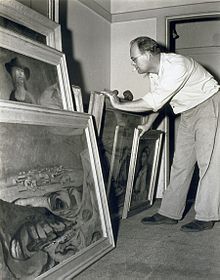Russell Drysdale
| Sir Russell Drysdale | |
|---|---|

Russell Drysdale with some canvases, taken by Australian photographer Max Dupain
|
|
| Born |
7 February 1912 Bognor Regis, England |
| Died | 29 June 1981 (aged 69) Sydney, Australia |
| Nationality | Australian |
| Known for | Painter |
Sir George Russell Drysdale, AC (7 February 1912 – 29 June 1981), also known as "Tass Drysdale", was an Australian artist. He won the prestigious Wynne Prize for Sofala in 1947, and represented Australia at the Venice Biennale in 1954. He was influenced by abstract and surrealist art, and "created a new vision of the Australian scene as revolutionary and influential as that of Tom Roberts".
George Russell Drysdale was born in Bognor Regis, Sussex, England, to an Anglo-Australian pastoralist family, which settled in Melbourne, Australia in 1923. Drysdale was educated at Geelong Grammar School. He had poor eyesight all his life, and was virtually blind in his left eye from age 17 due to a detached retina. Drysdale worked on his uncle's estate in Queensland, and as a jackaroo in Victoria. A chance encounter in 1932 with artist and critic Daryl Lindsay awakened him to the possibility of a career as an artist. Supported by a fellow artist, Drysdale studied with the modernist artist and teacher George Bell in Melbourne from 1935 to 1938. He also made several trips to Europe; during 1938–39, he attended the Grosvenor School in London and the Grande Chaumière in Paris. By the time of his return from the third of these trips in June 1939 Drysdale was recognised within Australia as an important emerging talent, but had yet to find a personal vision. His decision to leave Melbourne for Albury and then Sydney in 1940 was instrumental in his discovery of his lifelong subject matter, the Australian outback and its inhabitants. Equally important was the influence of fellow artist Peter Purves Smith in guiding him towards his characteristic mature style with its use of desolate landscapes inhabited by sparse figures under ominous skies.
...
Wikipedia
